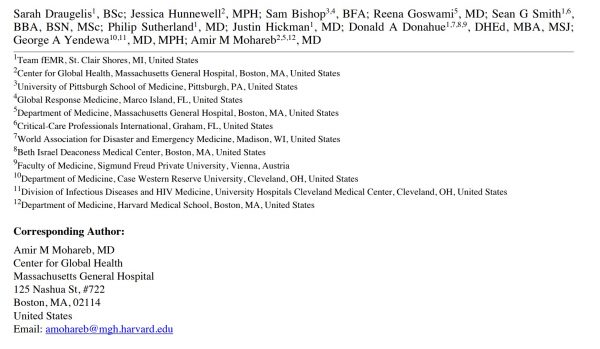Published in JMIR Public Health Surveill 2025 | vol. 11 | e66223 | p. 8
Abstract below.
Full publication: Leveraging Electronic Health Records in International Humanitarian Clinics

ABSTRACT
Background: As more humanitarian relief organizations are beginning to use electronic medical records in their operations, data from clinical encounters can be leveraged for public health planning. Currently, medical data from humanitarian medical workers are infrequently available in a format that can be analyzed, interpreted, and used for public health.
Objectives: This study aims to develop and test a methodology by which diagnosis and procedure codes can be derived from free-text medical encounters by medical relief practitioners for the purposes of data analysis.
Methods: We conducted a cross-sectional study of clinical encounters from humanitarian clinics for displaced persons in Mexico between August 3, 2021, and December 5, 2022. We developed and tested a method by which free-text encounters were reviewed by medical billing coders and assigned codes from the International Classification of Diseases, Tenth Revision (ICD-10) and the Current Procedural Terminology (CPT). Each encounter was independently reviewed in duplicate and assigned ICD-10 and CPT codes in a blinded manner. Encounters with discordant codes were reviewed and arbitrated by a more experienced medical coder, whose decision was used to determine the final ICD-10 and CPT codes. We used chi-square tests of independence to compare the ICD-10 codes for concordance across single-diagnosis and multidiagnosis encounters and across patient characteristics, such as age, sex, and country of origin.
Results: We analyzed 8460 encounters representing 5623 unique patients and 2774 unique diagnosis codes. These free-text encounters had a mean of 20.5 words per encounter in the clinical documentation. There were 58.78% (4973/8460) encounters where both coders assigned 1 diagnosis code, 18.56% (1570/8460) encounters where both coders assigned multiple diagnosis codes, and 22.66% (1917/8460) encounters with a mixed number of codes assigned. Of the 4973 encounters with a single code, only 11.82% (n=588) had a unique diagnosis assigned by the arbitrator that was not assigned by either of the initial 2 coders. Of the 1570 encounters with multiple diagnosis codes, only 3.38% (n=53) had unique diagnosis codes assigned by the arbitrator that were not initially assigned by either coder. The frequency of complete concordance across diagnosis codes was similar across sex categories and ranged from 30.43% to 46.05% across age groups and countries of origin.
Conclusions: Free-text electronic medical records from humanitarian relief clinics can be used to develop a database of diagnosis and procedure codes. The method developed in this study, which used multiple independent reviews of clinical encounters, appears to reliably assign diagnosis codes across a diverse patient population in a resource-limited setting.